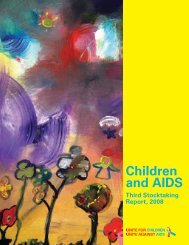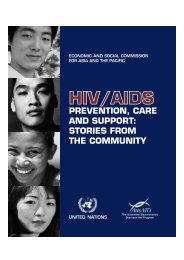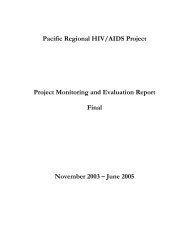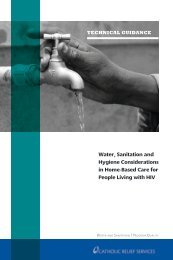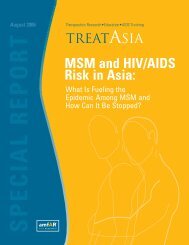Assessing HIV/AIDS Initiatives in China - Center for Strategic and ...
Assessing HIV/AIDS Initiatives in China - Center for Strategic and ...
Assessing HIV/AIDS Initiatives in China - Center for Strategic and ...
Create successful ePaper yourself
Turn your PDF publications into a flip-book with our unique Google optimized e-Paper software.
vi <strong>Assess<strong>in</strong>g</strong> <strong>HIV</strong>/<strong>AIDS</strong> <strong>Initiatives</strong> <strong>in</strong> Ch<strong>in</strong>a<br />
Lack of F<strong>in</strong>ancial <strong>and</strong> Human Resources<br />
A debilitated <strong>and</strong> dysfunctional public health system, particularly <strong>in</strong> rural areas where<br />
<strong>HIV</strong> is hitt<strong>in</strong>g hardest, underm<strong>in</strong>es an effective response to <strong>HIV</strong>/<strong>AIDS</strong>. The vast majority<br />
of <strong>HIV</strong>-positive persons <strong>and</strong> those at highest risk of contract<strong>in</strong>g <strong>HIV</strong> live <strong>in</strong> some of the<br />
poorest <strong>and</strong> most remote regions of the country—such as <strong>in</strong> Yunnan, Guangxi, Sichuan,<br />
Henan, Anhui, <strong>and</strong> X<strong>in</strong>jiang prov<strong>in</strong>ces—further complicat<strong>in</strong>g an effective response.<br />
Overall, resources <strong>and</strong> capacity are lack<strong>in</strong>g at many levels. Medical professionals lack the<br />
expertise <strong>and</strong> necessary <strong>in</strong>centives to treat <strong>HIV</strong>/<strong>AIDS</strong> patients, as well as the necessary<br />
equipment <strong>and</strong> technologies to properly diagnose, counsel, treat, monitor, <strong>and</strong> care <strong>for</strong><br />
them. Ancillary treatment, counsel<strong>in</strong>g, <strong>and</strong> social services are not sufficiently available to<br />
those <strong>in</strong> need.<br />
Blood Supply: Better, but Still Question Marks<br />
S<strong>in</strong>ce the mid-1990s, the government has stepped up its ef<strong>for</strong>ts to regulate the<br />
commercial blood supply, a move that has reduced the threat of spread<strong>in</strong>g <strong>HIV</strong> through<br />
unsanitary blood collection methods. In addition, <strong>in</strong> certa<strong>in</strong> parts of the country, the<br />
government has suspended m<strong>and</strong>atory blood collection quotas. Rely<strong>in</strong>g on voluntary<br />
donations will improve the chances of avoid<strong>in</strong>g ta<strong>in</strong>ted blood supplies. Yet these<br />
government ef<strong>for</strong>ts may have driven the practice of commercial blood donation<br />
underground with potentially greater risks to donors <strong>and</strong> recipients. In March 2004, a<br />
CCTV report exposed the mismanagement of a plasma collection station <strong>in</strong> Deq<strong>in</strong>g<br />
county, Guangdong, where techniques used were similar to those that caused the spread<br />
of <strong>HIV</strong> <strong>in</strong> the early to mid-1990s <strong>in</strong> central Ch<strong>in</strong>a. Reports <strong>in</strong>dicated that by 2003, 15<br />
percent of the blood used <strong>in</strong> Ch<strong>in</strong>a was collected from sellers <strong>and</strong> that some 50 illegal<br />
blood stations had to be closed down <strong>in</strong> late 2004.<br />
<strong>HIV</strong> Education, Awareness, Prevention, <strong>and</strong> Test<strong>in</strong>g Still Lag Beh<strong>in</strong>d<br />
Greater emphasis is needed on <strong>HIV</strong> education, awareness, prevention, <strong>and</strong> test<strong>in</strong>g. Stigma<br />
associated with <strong>HIV</strong>/<strong>AIDS</strong> as well as with behaviors that spread <strong>HIV</strong> rema<strong>in</strong>s a major<br />
barrier to successful implementation of many programs—<strong>in</strong>clud<strong>in</strong>g l<strong>in</strong>ger<strong>in</strong>g stigma even<br />
among health care workers.<br />
Encourag<strong>in</strong>g advances have been made <strong>in</strong> treat<strong>in</strong>g <strong>HIV</strong>/<strong>AIDS</strong> among rural farmers<br />
who contracted <strong>HIV</strong> through plasma donation <strong>and</strong> <strong>in</strong> prevent<strong>in</strong>g the further spread of<br />
<strong>HIV</strong> through illicit blood donation. However, the government rema<strong>in</strong>s poorly equipped to<br />
deal with those who are most at risk of contract<strong>in</strong>g <strong>and</strong> spread<strong>in</strong>g <strong>HIV</strong>/<strong>AIDS</strong>, particularly<br />
highly stigmatized <strong>and</strong> marg<strong>in</strong>alized populations. <strong>HIV</strong>-test<strong>in</strong>g capacity is severely<br />
stretched.<br />
Role of Nongovernmental Organizations <strong>and</strong> Civil Society<br />
Nongovernmental organizations (NGOs), both domestic <strong>and</strong> <strong>in</strong>ternational, cont<strong>in</strong>ue to<br />
walk a f<strong>in</strong>e l<strong>in</strong>e <strong>in</strong> Ch<strong>in</strong>a <strong>and</strong> need to be constantly cautious <strong>and</strong> restra<strong>in</strong>ed <strong>in</strong> their<br />
activities to avoid political, legal, <strong>and</strong> f<strong>in</strong>ancial complications with local <strong>and</strong> central<br />
authorities. Although there clearly are bright spots <strong>and</strong> encourag<strong>in</strong>g prelim<strong>in</strong>ary results<br />
from many pilot projects, few have “scaled up” or exp<strong>and</strong>ed to provide services to a<br />
wider population.



